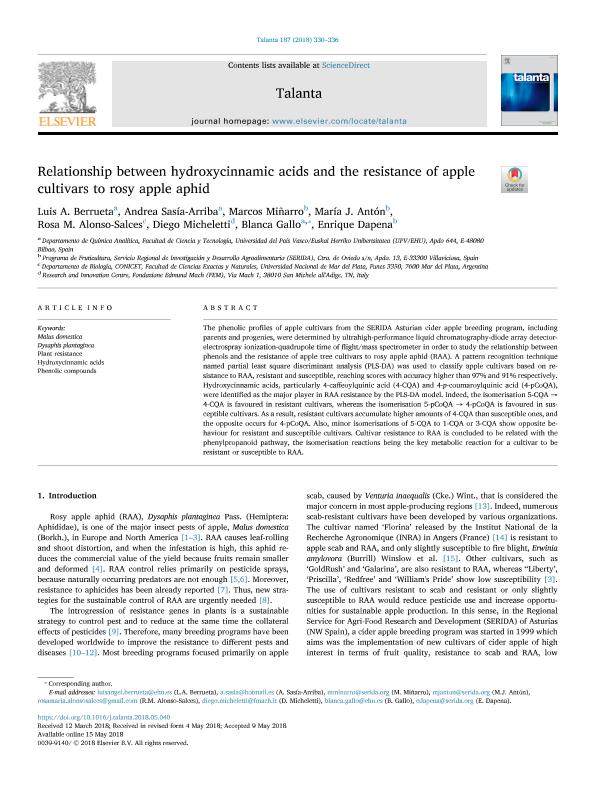Artículo
Relationship between hydroxycinnamic acids and the resistance of apple cultivars to rosy apple aphid
Berrueta, Luis A.; Sasía-Arriba, Andrea; Miñarro, Marcos; Antón, María J.; Alonso Salces, Rosa Maria ; Micheletti, Diego; Gallo, Blanca; Dapena, Enrique
; Micheletti, Diego; Gallo, Blanca; Dapena, Enrique
 ; Micheletti, Diego; Gallo, Blanca; Dapena, Enrique
; Micheletti, Diego; Gallo, Blanca; Dapena, Enrique
Fecha de publicación:
09/2018
Editorial:
Elsevier Science
Revista:
Talanta
ISSN:
0039-9140
Idioma:
Inglés
Tipo de recurso:
Artículo publicado
Clasificación temática:
Resumen
The phenolic profiles of apple cultivars from the SERIDA Asturian cider apple breeding program, including parents and progenies, were determined by ultrahigh-performance liquid chromatography-diode array detector-electrospray ionization-quadrupole time of flight/mass spectrometer in order to study the relationship between phenols and the resistance of apple tree cultivars to rosy apple aphid (RAA). A pattern recognition technique named partial least square discriminant analysis (PLS-DA) was used to classify apple cultivars based on resistance to RAA, resistant and susceptible, reaching scores with accuracy higher than 97% and 91% respectively. Hydroxycinnamic acids, particularly 4-caffeoylquinic acid (4-CQA) and 4-p-coumaroylquinic acid (4-pCoQA), were identified as the major player in RAA resistance by the PLS-DA model. Indeed, the isomerisation 5-CQA → 4-CQA is favoured in resistant cultivars, whereas the isomerisation 5-pCoQA → 4-pCoQA is favoured in susceptible cultivars. As a result, resistant cultivars accumulate higher amounts of 4-CQA than susceptible ones, and the opposite occurs for 4-pCoQA. Also, minor isomerisations of 5-CQA to 1-CQA or 3-CQA show opposite behaviour for resistant and susceptible cultivars. Cultivar resistance to RAA is concluded to be related with the phenylpropanoid pathway, the isomerisation reactions being the key metabolic reaction for a cultivar to be resistant or susceptible to RAA.
Archivos asociados
Licencia
Identificadores
Colecciones
Articulos(CCT - MAR DEL PLATA)
Articulos de CTRO.CIENTIFICO TECNOL.CONICET - MAR DEL PLATA
Articulos de CTRO.CIENTIFICO TECNOL.CONICET - MAR DEL PLATA
Citación
Berrueta, Luis A.; Sasía-Arriba, Andrea; Miñarro, Marcos; Antón, María J.; Alonso Salces, Rosa Maria; et al.; Relationship between hydroxycinnamic acids and the resistance of apple cultivars to rosy apple aphid; Elsevier Science; Talanta; 187; 9-2018; 330-336
Compartir
Altmétricas



